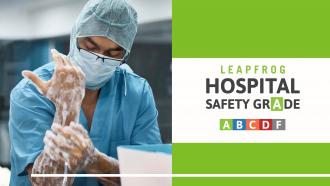
The Leapfrog Group, a national watchdog organization of employers and other purchasers focused on health care safety and quality, today released the fall 2020 Leapfrog Hospital Safety Grades. Assigning “A,” “B,” “C,” “D,” and “F” letter grades to general acute-care hospitals in the U.S., the Safety Grade is the only rating focused entirely on how well hospitals protect patients from preventable errors, accidents, injuries, and infections.
“We see in the news every day the extraordinary courage of clinicians and staff caring for patients stricken by COVID-19. What’s less apparent—yet equally laudable—are the untold efforts behind the scenes to protect patients. Hospitals’ commitment to the fundamentals have saved lives too, like preventing infection, ensuring universal hand hygiene, and double and triple checking everything to avoid errors,” said Leah Binder, president and CEO of The Leapfrog Group. “We are grateful for the heroic efforts of hospitals across the Nation and applaud their efforts that are protecting our families.”
Given heightened public concern about infection during the pandemic, Leapfrog is also releasing a new playbook for the community titled, Protecting Yourself During the Respiratory Illness Season. Developed by a team of volunteer experts and advisors, the free playbook serves as a guide for the public on steps they can take to decrease their risk of sickness, including how proper handwashing can prevent disease. It adds to Leapfrog’s robust set of resources on how to stay safe in the hospital.
Across all states, highlights of findings from the fall 2020 Leapfrog Hospital Safety Grade include:
- 34% of hospitals were graded “A’s,” 24% were “B’s,” 35% were “C’s,” 7% were “D’s,” and less than 1% were “F’s”
- Five states with the highest percentages of “A” hospitals are Maine, Idaho, Delaware, Massachusetts and Oregon
- There were no “A” hospitals in Alaska, South Dakota and North Dakota
- Notably, 29 hospitals nationwide have achieved an “A” in every grading update since the launch of the Safety Grade in spring 2012
The Leapfrog Hospital Safety Grade is reviewed by a National Expert Panel and receives guidance from Johns Hopkins Medicine’s Armstrong Institute for Patient Safety and Quality. The biannual Leapfrog Hospital Safety Grade is independently assessed, peer-reviewed, fully transparent and free to the public. It shares critical patient safety information to consumers, so that they can make informed decisions about where they seek care.
Data used to calculate Hospital Safety Grades include up to 27 measures, gathered primarily from the Leapfrog Hospital Survey and the Centers for Medicare and Medicaid Services (CMS). While the data does not yet include findings collected during the height of COVID-19, the data offers an indication of how well hospitals implemented fundamental safety precautions prior to the pandemic, an important factor in preparedness. The Hospital Safety Grade is updated every six months and future updates will incorporate pandemic response periods.
For more information about the Safety Grades, as well as individual hospital grades and state rankings, please visit hospitalsafetygrade.org and follow The Leapfrog Group on Facebook and Twitter. Journalists interested in scheduling an interview with a Leapfrog representative should contact erin.berst@curastrategies.com.
About The Leapfrog Group
Founded in 2000 by large employers and other purchasers, The Leapfrog Group is a national nonprofit organization driving a movement for giant leaps forward in the quality and safety of American health care. The flagship Leapfrog Hospital Survey and new Leapfrog Ambulatory Surgery Center (ASC) Survey collect and transparently report hospital and ASC performance, empowering purchasers to find the highest-value care and giving consumers the lifesaving information they need to make informed decisions. The Leapfrog Hospital Safety Grade, Leapfrog’s other main initiative, assigns letter grades to hospitals based on their record of patient safety, helping consumers protect themselves and their families from errors, injuries, accidents, and infections.
